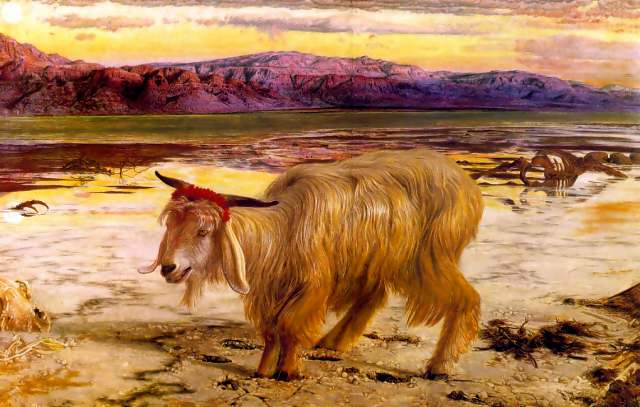- The Scapegoat (painting)
backcolor=#FBF5DF
painting_alignment=right
image_size=350px
title= The Scapegoat
artist=William Holman Hunt
year= 1856
type=Oil on canvas
height=
width=
height_inch=34
width_inch =55
diameter_cm =
diameter_inch =
city=Port Sunlight
museum=Lady Lever Art Gallery "The Scapegoat" (1856) is a painting by
William Holman Hunt which depicts the "scapegoat " described in theBook of Leviticus , which must be ritually expelled from the flocks of the Israelite tribes as part of a sacrificial ritual of cleansing. In line with traditional Christian theology, Hunt believed that the scapegoat was a prototype for the redemptive sacrifice ofJesus , and that the goat represented that aspect of theMessiah described inIsaiah as a "suffering servant" of God. Hunt had the picture framed with the quotations "Surely he hath borne our Griefs and carried our Sorrows; Yet we did esteem him stricken, smitten of GOD and afflicted." (Isaiah 53:4) and "And the Goat shall bear upon him all their iniquities unto a Land not inhabited." (Leviticus 16:22)In the
Royal Academy exhibition catalogue Hunt wrote that "the scene was painted at Oosdoom, on the margin of the salt-encrusted shallows of theDead Sea . The mountains beyond are those ofEdom ." [Bronkhurst, Judith, "Wiliam Holman Hunt, A Catalogue Raisonné", vol. 1, p.180.]Meaning
The painting was the only major work completed by Hunt during his first trip to the Holy Land, to which he had travelled after a crisis of religious faith. Hunt intended to experience the actual locations of the Biblical narratives as a means to confront the relationship between faith and truth. While in Jerusalem Hunt had met
Henry Wentworth Monk , a millenarian prophet who had distinctive theories about the meaning of the scapegoat and the proximity of theLast Judgement . Monk was particularly preoccupied withChristian Zionism .Hunt chose a subject derived from the
Torah as part of a project to convert Jews to Christianity. He believed that Judaic views of the scapegoat were consistent with the Christian conception of the Messiah as a suffering figure. He wrote to his friendMillais , "I am sanguine that that [the Scapegoat] may be a means of leading any reflecting Jew to see a reference to the Messiah as he was, and not as they understand, a temporal King." [Fleming, G.H.," John Everett Millais: A Biography", 1998, Constable, p.158]Notes
External links
* [http://www.liverpoolmuseums.org.uk/walker/pre-raphaelites/scapegoat/scapegoat.asp 'The Scapegoat' (1854)] at the [http://www.liverpoolmuseums.org.uk/ladylever/index.aspx/ Lady Lever Art Gallery, Port Sunlight]
* [http://www.english.uwosh.edu/roth/huntarticle.htm "William Holman Hunt's The Scapegoat: Rite of Forgiveness/Transference of Blame"]
Wikimedia Foundation. 2010.

